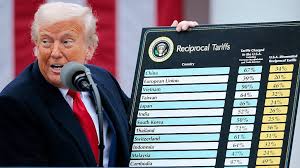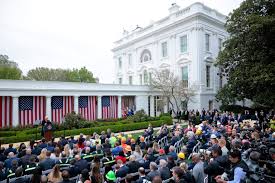
Uganda to face a 10% levy on its good exported to the United States. On April 2nd 2025, Donald Trump announced a sweeping set of tariffs marking a significant shift in us trade policy. Delivered from the White House Rose Garden, Trump’s announcement positioned the new tariffs as a bold move to liberate the US from its reliance on foreign goods, a key promise of his administration.
In a speech dubbed “Liberation Day” trump declared the the new tariffs would herald the the rebirth of the American industry. “April 2nd 2025 will forever be remembered as the day the American industry was reborn “ said trump stressing that the tariffs would lead to economic prosperity and renewed national destiny.
Details of the tariff plan.
The new plan introduced a baseline tariffs of 10% on all imported goods, taking effect on April 5th 2025. in addition, a series of “kind reciprocal” tariffs — meant to counter what the administration deemed unfair trading practices will apply to 180 countries start April 9th at midnight. These tariffs will be targeting specific countries deemed as major trade offenders. The most notable targets were the European union, China, Taiwan, Vietnam, Japan, Myanmar which were accused of taking advantage of the US trade policies. Trump specifically said China would face a 34% tariff on top of the existing ones making the tariffs at 54%. The administration says these rates are designed to approximate half of what these countries impose on American products though critics argue that the figures are misleading.

Economic and political fallout.
The administration justified the tariffs by citing trade deficits, currency manipulation and other alleged unfair practices. Trump described these deficits as a national emergency asserting that trade policies had weakened the country.
However, the move has drawn swift backlash from both allies and economists. Canada and the European Union have vowed to retaliate, while Mexico is expected to respond soon. Critics warn that the tariffs could drive up costs for American consumers and disrupt the economic markets.
On Capitol Hill, Opposition is mounting, a senate resolution challenging Trump’s ability to impose tariffs on Canada narrowly passed, though it faces an uncertain future in the House. Meanwhile Democrats have threatened to fight the policy, calling it a reckless economic gamble.
Despite concerns, the White House is pushing forward, arguing that any short-term economic pain will be outweighed by the long term gains in jobs and manufacturing. “factories will come roaring back.” trump promised . “more production at home means lower prices for consumers.
Still, public sentiment remains undivided. A recent AP-NORC poll found out that 60% of Americans disapprove of Trump’s trade policies , with concerns growing over potential price hikes. Even among Republicans, skepticism is rising.
As the new tariffs take effect over the coming days, their impact — both economic and political — will become clearer. For now, the administration remains steadfast, betting that its aggressive trade stance will pay off in the long run.



